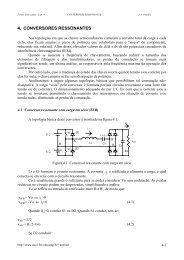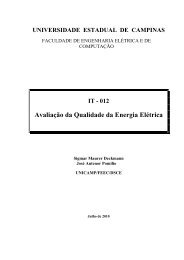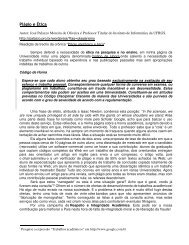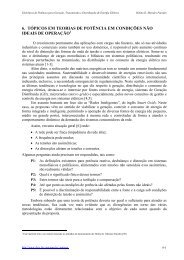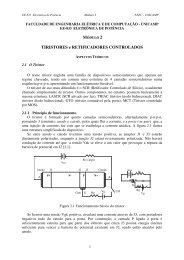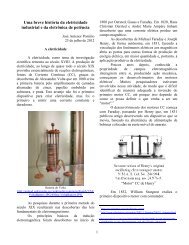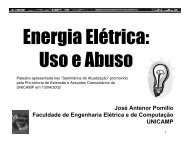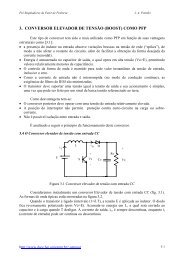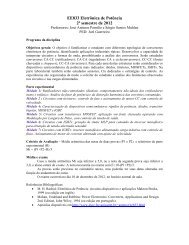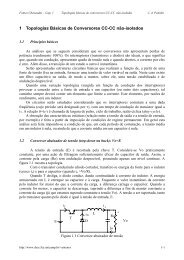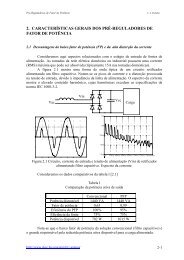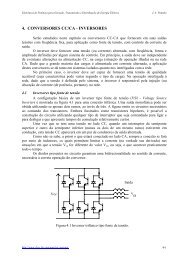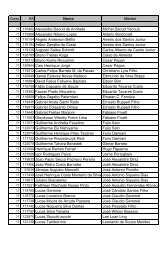Controle Direto de Torque do Motor de Indução ... - D.s.c.e. - Unicamp
Controle Direto de Torque do Motor de Indução ... - D.s.c.e. - Unicamp
Controle Direto de Torque do Motor de Indução ... - D.s.c.e. - Unicamp
Create successful ePaper yourself
Turn your PDF publications into a flip-book with our unique Google optimized e-Paper software.
48 <strong>Controle</strong> <strong>Direto</strong> <strong>de</strong> <strong>Torque</strong> <strong>do</strong> <strong>Motor</strong> <strong>de</strong> <strong>Indução</strong> Trifásico<br />
Tab. 3.4: Vetores Espaciais <strong>de</strong> Tensão<br />
Vetor <strong>de</strong> Tensão <strong>de</strong> Linha Vetor <strong>de</strong><br />
Chaveamento<br />
�S1(100)<br />
Uab<br />
Ucc<br />
Ubc<br />
0<br />
Uca<br />
−Ucc<br />
Tensão<br />
�U1 = 2<br />
√<br />
3Ucc ·e 3<br />
jπ/6<br />
�S2(110) 0 Ucc −Ucc<br />
�U2 = 2<br />
√<br />
3Ucc ·e 3<br />
j3π/6<br />
�S3(010) −Ucc Ucc 0 U3<br />
� = 2<br />
√<br />
3Ucc ·e 3<br />
j5π/6<br />
�S4(011) −Ucc 0 Ucc<br />
�U4 = 2<br />
√<br />
3Ucc ·e 3<br />
j7π/6<br />
�S5(001) 0 −Ucc Ucc<br />
�U5 = 2<br />
√<br />
3Ucc ·e 3<br />
j9π/6<br />
√<br />
3Ucc ·ej11π/6 �S6(101) Ucc −Ucc 0 U6<br />
� = 2<br />
3<br />
�S0(000) 0 0 0 � U0 = 0<br />
�S7(111) 0 0 0 � U7 = 0<br />
Do anterior conclui-se que existem seis vetores <strong>de</strong> tensão ativos � U1, � U2, � U3, � U4, � U5, � U6 e <strong>do</strong>is ve-<br />
tores nulos � U0, � U7. Também é possível ter uma representação gráfica <strong>do</strong>s vetores <strong>de</strong> tensão ativos<br />
e nulos como mostra<strong>do</strong> na figura (3.17), observa-se também que o hexágono foi dividi<strong>do</strong> em seis<br />
setores bem <strong>de</strong>fini<strong>do</strong>s.<br />
�U4<br />
�S4(011)<br />
Uca<br />
�S3(010)<br />
�U3<br />
III<br />
�U5<br />
�S5(001)<br />
�S0(000)<br />
�S7(111)<br />
IV<br />
Ubc<br />
II<br />
V<br />
�U0<br />
�S2(110)<br />
I<br />
�U2<br />
� U6<br />
Uab<br />
�U1<br />
�U7 S1(100) �<br />
VI<br />
� S6(101)<br />
Fig. 3.17: Vetores <strong>de</strong> Chaveamento e Vetores <strong>de</strong><br />
Tensão<br />
β<br />
α<br />
�U4<br />
Uca<br />
�U3<br />
�U5<br />
�U0<br />
�U7<br />
Ubc<br />
β<br />
�U ∗<br />
�U2<br />
| � U ∗ | = Ucc<br />
| � U1| = 2 √ 3 Ucc<br />
�U6<br />
Uab<br />
Fig. 3.18: Limiar Para Uma Onda Senoidal<br />
Para conseguir sintetizar uma forma <strong>de</strong> onda senoidal nas tensões <strong>de</strong> linha trifásicas, a máxima<br />
amplitu<strong>de</strong> <strong>do</strong>s vetores espaciais está limitada ao valor <strong>do</strong> barramento CC (Ucc) forman<strong>do</strong> um círculo<br />
inscrito no hexágono cujo raio éUcc (Fig. 3.18).<br />
Consi<strong>de</strong>remos o vetor tensão � U ∗ a ser sintetiza<strong>do</strong>, este vetor está no setor I (3.19), consi<strong>de</strong>ra-se<br />
também que para um perío<strong>do</strong> <strong>de</strong> chaveamento suficientemente pequeno, tem-se que:<br />
�U1<br />
α



